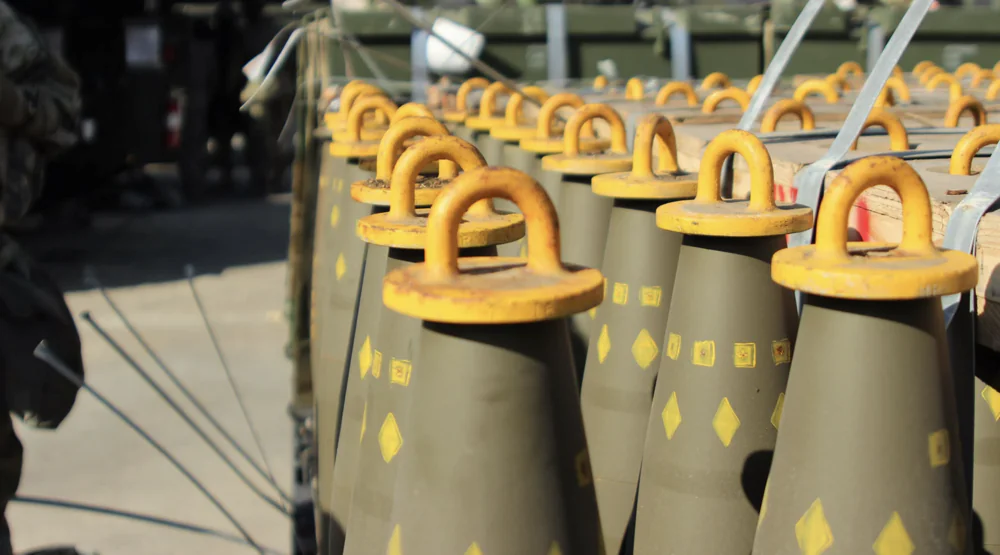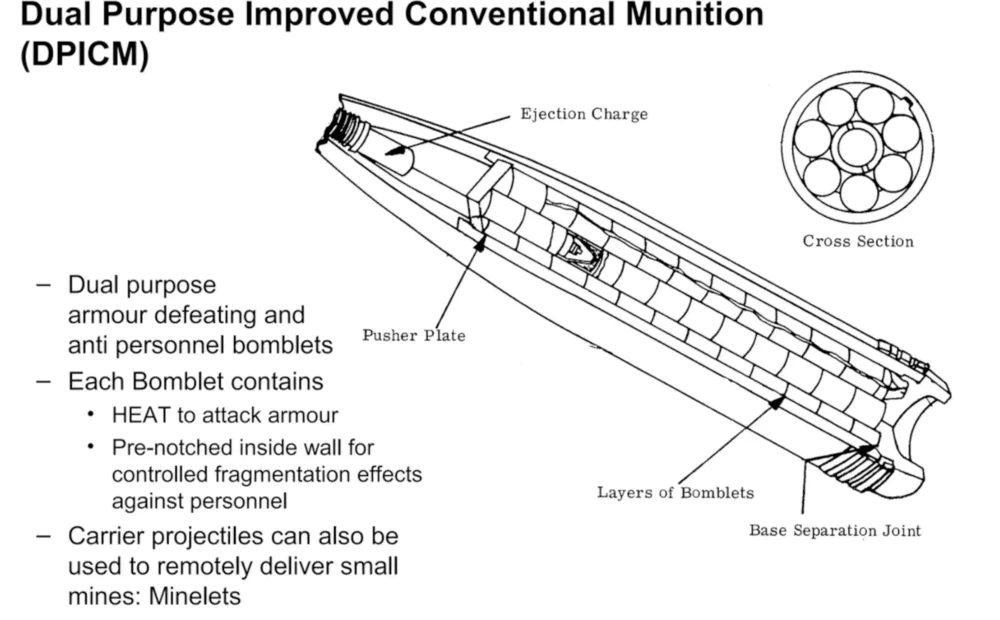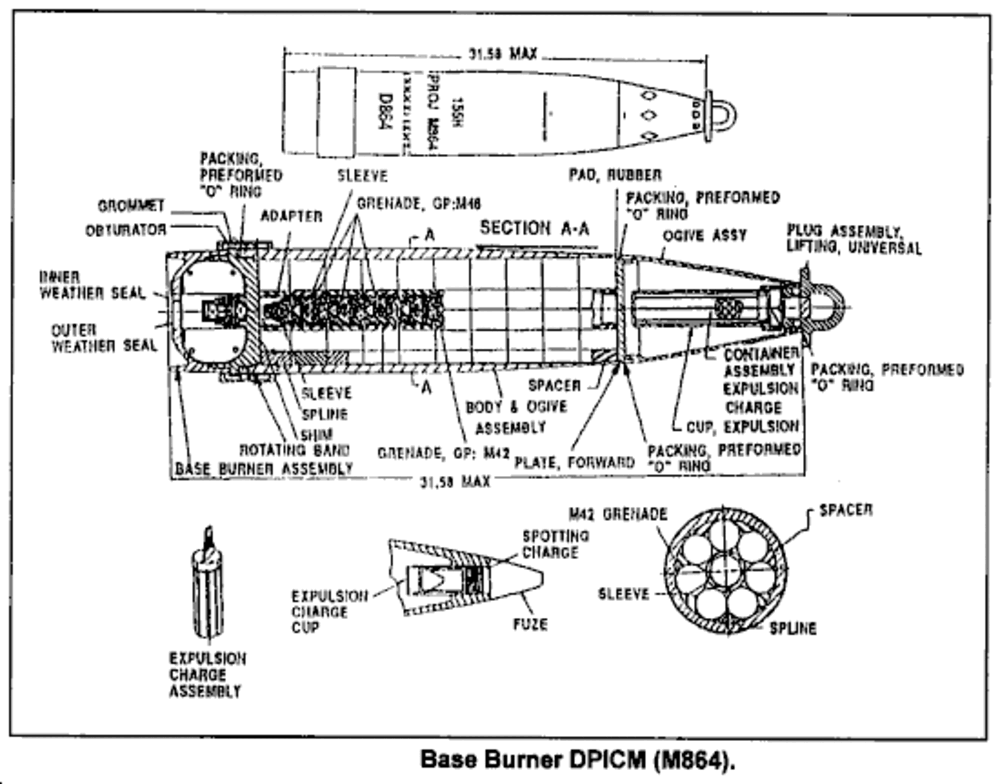© ROOT-NATION.com - Use of content is permitted with a backlink.
The United States has decided to provide Ukraine with cluster munitions to help the Ukrainian Armed Forces liberate its territory from Russian invaders.
It should be noted at the outset that cluster munitions are a highly controversial and widely banned weapon, the use of which can cause indiscriminate harm to civilians, especially children, even long after the end of hostilities. However, these weapons can help the Ukrainian armed forces to conduct counter-offensive operations.

Our leadership has been asking for these cluster munitions for a long time, as they will allow our Armed Forces to effectively hit the fortified positions of the Russians and overcome the lack of manpower and artillery. Let’s take a closer look at the American cluster munitions.
Read also: All about the 155mm M777 howitzer and M982 Excalibur guided projectile
What is cluster munitions?
Cluster munitions contain containers that open in the air and scatter large numbers of explosive submunitions or “small bombs” over a large area. Depending on the model, the number of submunitions can range from a few dozen to more than 600. Cluster munitions can be dropped from aircraft or delivered to the target by artillery or missiles.

Most submunitions are designed to explode on impact. The vast majority of them are free-falling, meaning that they are not individually fired.
Cluster munitions were first used during the Second World War, and a large part of the existing stockpile of cluster munitions was accumulated during the Cold War. Their main purpose is to destroy numerous military targets scattered over a large area, such as tank or infantry formations.
Read also: Weapons of Ukrainian Victory: BAE Systems CV90 infantry fighting vehicle
What are our American partners planning to send to the Ukrainian Armed Forces?
It is known that the United States will send Ukraine 155mm artillery shells loaded with explosive munitions called dual-purpose improved conventional munitions, or DPICMs. The shells are designed to explode in the air and scatter ammunition over the terrain to attack both armoured vehicles and infantry.
I should note that the US military has two main 155mm DPICM rounds in service. These are the M483 cluster munitions, which contain 88 grenade-like munitions, and the M864 long-range munitions, which contain 72 grenade-like munitions. It is not yet known which version is being considered for supply to the Ukrainian Armed Forces.

Both munitions use the same type of DPICM grenades, which sometimes do not explode immediately upon landing due to environmental factors such as vegetation or soft ground. The grenades do not have the ability to self-destruct and often remain dangerous even decades after use, and can explode if mishandled, as grenade fuses are particularly sensitive.
Read also: Weapon of Ukrainian Victory: German Self-Propelled Howitzer Boxer RCH 155
What do we know about DPICM?
A DPICM is a surface-to-surface artillery or missile warhead that fires tens to hundreds of smaller submunitions that can use high explosive anti-tank warheads and fragmentation warheads for anti-personnel warfare. A type of air-to-surface munition is known as a cluster bomb. A single munition can destroy multiple targets simultaneously, making it more effective than any conventional shell or bomb.

DPICM is a general category that includes various types of artillery shells and rockets fitted with several types of submunitions that have roughly the same function and purpose. The bulk of DPICM ammunition production took place between the 1970s and 1990s. These include rounds for 105mm, 155mm and 203mm howitzers, as well as 227mm artillery rockets that can be launched from the M270 and M142 multiple launch rocket systems (MLRS) and Highly Mobile Artillery Rocket Systems (HIMARS).
The DPICM evolved from the previous series of cluster munitions, the Improved Conventional Munition (ICM). The “dual purpose” of DPICM submunitions, which the US Army calls “grenades”, is that they are designed to be effective against both armoured vehicles and softer targets such as unarmoured vehicles and infantry units.

Development of DPICM projectiles began in the late 1950s. The first round, the 105mm M444, entered service with the US Army in 1961. Its submunitions were simple anti-personnel grenades (ICM). Production of the M444 ended in the early 1990s.

The first real DPICM was the 155mm M483 cluster munition, produced in the 1970s. An improved version, the M483A1, was used until 1975. The round carried 88 M42/M46 dual-purpose grenade-like munitions. Its successor, the 155mm M864, entered production in 1987 and featured a base warhead that increased the range of the projectile. However, it still carries the same M42/M46 grenades. The basic fuzing mechanism reduces the number of submunitions to 72. In 2003, the budget included work to upgrade the M42/M46 grenades with a self-destruct system to reduce the problem of “unexploded” submunitions, which are dangerous for demining and for civilians.

Work on 105mm rounds based on the M80 submunition began in the late 1990s: The M915, designed for use with the M119A1 light towed howitzer, and the M916, developed for the M101/M102 howitzers.
DPICM submunitions were developed for several reasons:
- They can give a heavy, closed-loop gun the ability to hit a larger area, with a spread that compensates for their inherent inaccuracy.
- Artillery can use DPICMs to great effect against armoured and mechanised formations, being able to destroy armour without the need for laser-guided ATGMs such as the Copperhead.
- Because they can explode in the air, they are more effective against dug-in troops than conventional high-explosive rounds.
Read also: Weapons of Ukrainian victory: French Crotale SAM
155 mm cassette shell M864
Let’s take a closer look at one of these munitions, the 155mm M864 cluster munition. This is a dual-purpose DPICM round that uses base combustion technology to increase the range. The projectile is capable of delivering 24 M46 grenades and 48 M42 dual-purpose grenades at a range of up to 29 kilometres.
It is a basic catapult projectile that carries 72 DP grenades (48 M42 grenades and 24 M46 grenades). The grenades provide the projectile with a double capacity. However, a third use can be achieved by replacing the original charge with a point charge, which is used in high-explosive shells. After the shot is fired, the powder ignites the base burner, which releases hot gas and increases the range of the projectile. At a predetermined time of flight, the grenades are ejected and detonate in midair as they fall. They can also explode when they hit the ground

The 155 mm M864 submunition is a long-range payload capable of delivering a payload of 72 M42/46 grenades to a range of 28.4 km and provides a 200% increase in coverage compared to the M483A1.
The M864 is a separately fuzed munition with a low-drag forged steel body made of 1340 or 4190 alloy and a steel fuze. A sliding metal firing pin surrounds the rear of the case.
 Although there are several types of DPICM submunitions, they are all designed in the same way: a high explosive charge designed to penetrate armour, surrounded by a casing specifically designed to send deadly fragments flying in all directions. The M864’s submunitions, which are similar in size and weight to a conventional hand grenade, are unguided, but each has a tassel-like piece of cloth at the top to stabilise the grenade as it falls. Artillery shells and other DPICM-filled munitions typically eject submunitions from the rear of the projectile or warhead after it reaches a predetermined point in its trajectory.
Although there are several types of DPICM submunitions, they are all designed in the same way: a high explosive charge designed to penetrate armour, surrounded by a casing specifically designed to send deadly fragments flying in all directions. The M864’s submunitions, which are similar in size and weight to a conventional hand grenade, are unguided, but each has a tassel-like piece of cloth at the top to stabilise the grenade as it falls. Artillery shells and other DPICM-filled munitions typically eject submunitions from the rear of the projectile or warhead after it reaches a predetermined point in its trajectory.

Read also: Weapons of Ukrainian Victory: NASAMS air defense that protects Washington
Why are cluster munitions banned worldwide?
The Convention on Cluster Munitions (CCM) of 2008 prohibits the use, production, transfer and stockpiling of cluster munitions and requires the destruction of stockpiles of such weapons, as well as the clean-up of areas contaminated by remnants and grenades and assistance to victims. At the same time, it should be noted that the cluster munitions convention has not been signed or ratified by the United States, Russia or Ukraine.

The weapon was banned for a good reason: inaccurate cluster munitions contaminate large areas and pose a direct threat to civilians. For example, cluster munitions endanger civilians because they hit a wide area, indiscriminately targeting military personnel and civilians alike. In addition, not all mini-munitions explode immediately upon impact: around 2.35 per cent of submunitions can remain on the ground and pose a danger to civilians for months, years or even decades after the conflict. Some mini-munitions attract children because they are brightly coloured or interestingly shaped. Due to their small size, they may not be noticed by farmers working in their fields.
Read also: Weapon of Ukrainian victory: 155 mm Vulcano guided artillery shell
Why does Ukraine need cluster munitions?
Ukraine’s counter-offensive has been slow so far due to dense Russian defences, which include minefields and particularly wide lines of trenches. Trenches can be very resistant to indirect fire, such as traditional artillery shells with unitary warheads. Direct fire, such as from cannons and tank guns, is even less effective. A significant number of unitary high-explosive artillery rounds may be required to hit them from above. Even then, their effectiveness may be limited against fortified enemy positions. Cluster munitions of artillery shells and rockets have the ability to cover a much larger area and do so faster and with fewer rounds, and submunitions can fall directly into trenches, with devastating consequences.
For Ukraine, cluster munitions can solve two main problems. First, it would meet the needs of the Ukrainian military to increase the amount of ammunition for artillery and missile systems provided by the West, and second, cluster munitions would allow Ukraine to get rid of Russia’s significant artillery advantage.

For the Ukrainian Armed Forces, there are a number of obvious potential uses for DPICM-loaded munitions that could be very useful. Ukraine already has the M142 HIMARS (think M30 precision-guided cluster missiles to HIMARS) and variants and derivatives of the M270, as well as NATO-standard 155mm and 105mm howitzers that can fire various types of DIPCM. There are also examples of US-made 203mm high explosive artillery rounds being used in Ukraine as ammunition for Soviet-made 2C7 Pion howitzers.
Unfortunately, the Russian army still has the advantage in terms of the number of artillery barrels, so the Ukrainian Armed Forces have no choice but to fight with quality rather than quantity. The quality of both the artillery itself and the shells for it. After all, for artillery to perform its functions efficiently and smoothly, it must be provided with high-quality ammunition in sufficient quantities.
This is where American cluster munitions come to the fore. They allow us to accurately and efficiently destroy the occupiers’ armoured vehicles and personnel over a large area. That is why we are sincerely grateful to our Western partners for their support and supply of modern weapons.
We believe in our defenders. The invaders will not escape from retribution. Death to the enemies! Glory to the Armed Forces! Glory to Ukraine!
Read also:
- Weapons of Ukrainian victory: AMX-10RC heavily armored vehicle
- Weapons of Ukrainian Victory: JDAM system – How to turn a conventional bomb into a high-precision one

